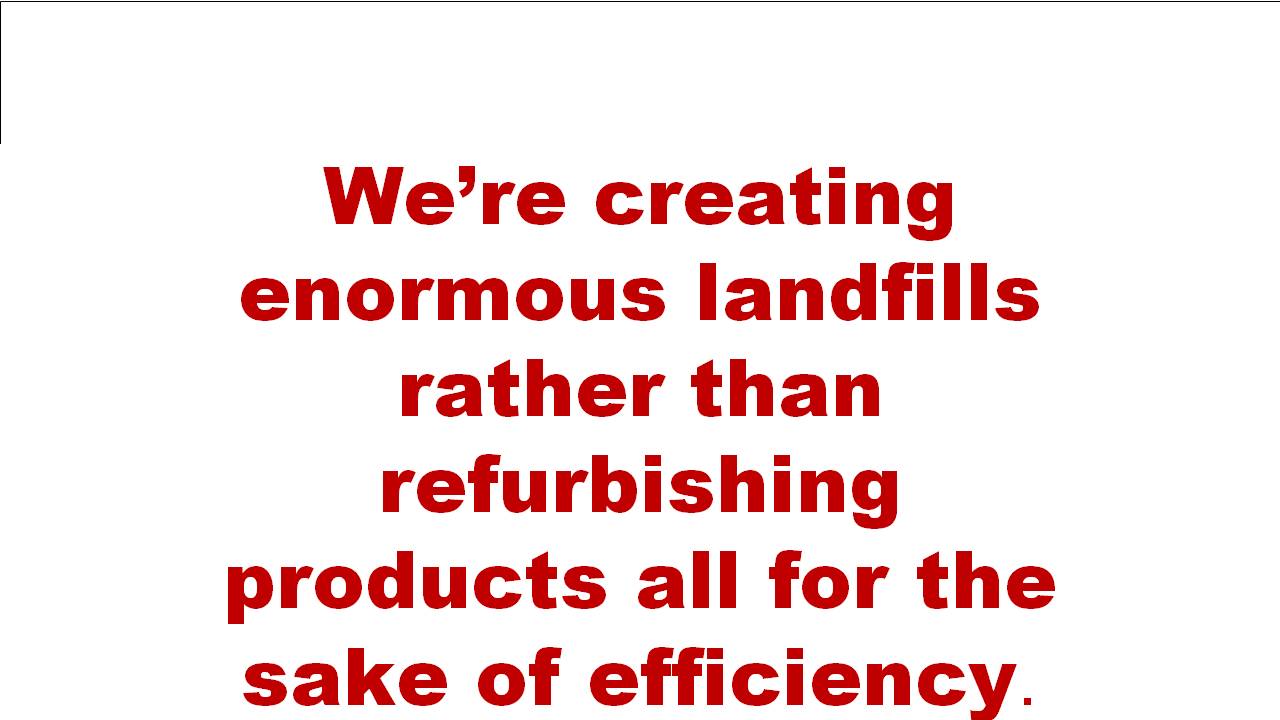by Peter A. Arthur-Smith
“Throwing repairable stuff away in order rack up the latest new product invoice.”
Have you had this experience? You want to repair a vertical window blind, where you inadvertently broke two of the small, plastic clasps that attach the vertical blades to the open-close window track. Those two components are likely worth no more than $10 each. It would likely take a window-blind technician no more than two hours to fix – say $150. Instead, your local window-blind shop throws up its hands and advises that you discard the minimally broken track and replace it with a new one costing, along with expert installation, around $800.
This all sounds like efficiency insanity, where the main beneficiaries will be the new track supplier, retailer and installer. All for no good reason other than to chase short-term numbers and produce landfills laden with discarded, largely good products that could’ve been fixed with a little, artisan ingenuity. Or a manufacturer’s willingness to retain parts for a certain amount of years rather than throw them into a landfill, too.
It’s reminiscent of some early army maneuver experiences with NATO in Germany, where American and British troops, among others, practiced war games. At that time, it was commonplace for the cash-strapped British technicians to locate defective parts within faulty communication equipment and either repair or replace any defective parts. Their American counterparts, however, would just replace the whole defective unit and then throw away the faulty one. That means they brought in a new unit costing say $20,000 rather than repair the old one for $500 covering parts and labor.
British troops used to envy their American counterparts for their financial nonchalance. Britain didn’t possess a wealthy empire anymore and America was still somewhat operating as the breadbasket to the world after WWII. No more! America’s economy is over $30T in debt with enormous pressures to raise that level. Economic and military issues with China, the Middle East, and Ukraine persist, so these beckon greater debt.
As the economies of Germany, Japan and England began to recover after WWII; they commenced exporting to America and started to eat into its healthy domestic market sales margins. Financial executives rose to the challenge and educated companies on efficiencies in order to remain competitive. Other costly wars have intervened with America’s military commitments in Vietnam, Europe, the Mid East and Afghanistan.
America and Wall Street’s answer to this growing fiscal conundrum has been to become obsessed with efficiency, where efficiency is code for cost-cutting, squeezing and immediate profitability. However, once you start down that track it instigates short-term thinking, which usually has a debilitating effect over time. Why? Because constant penny-pinching saps morale and doesn’t inspire elegant solutions. Elegant solutions are where more profound advances are made and the outcome feels and sounds like quality. That’s where efficiency’s sister comes into play – it’s called effectiveness.
The British army’s efficient approach all those years ago, and it still keeps cutting, has just about kept it going, although its ability to project power has only considerably diminished over the years. That has been reinforced by two of our current five world curses, bureaucracy and hierarchy. These along with our other current three curses of efficiency-think, negative-messaging, and different forms of corruption, have to be addressed by Britain to make economic breakthroughs and revitalize society through innovation. America has been heading down a similar track to Britain for a number of years. It has also caught the British and European efficiency and other-curse disease, which often leads to stagnation.
So, America is hampered by the same above five curses that act like brakes on their organizations and society, rather than pursue their five inducing antidotes – namely two-way communication, heterarchy, effectiveness-think, positive-messaging and integrity. Instead of fixating on management’s structure and systems, they will also focus on their leadership antidotes of architecture and configurations. Effective architecture and configurations usually draw upon generic formations, behaviors and elegance rather than manmade boxes and step-by-step methods that can be both daunting and time ineffective. The former two require a little extra time, patience and brainpower to figure them out, instead of relying on human pressure and competition to produce short-term solutions. Is it the tortoise and the hare all over again?
The starting point for a more effective approach is to have more enlightened leaders, who are more visionary, have courage to make tough decisions, use integrity to win the trust of people, allow humility to face its shortcomings, and invoke wisdom to find more elegant long-term solutions – rather than short-term, quick fixes. Wall Street can help by using its enormous brainpower to establish an effectiveness-exchange to complement its current efficiency one. It could also focus on elegant architectures rather than efficient structures, as well as on effective, natural configurations rather than efficient, numerical systems.
Such elegant architecture would help me configure the two parts I need to fix our vertical window-blind. My money saved can then wait in my bank account to help enrich the economy – truly wealthy nations are big savers – rather than pressurized through an efficiency-economy to make someone else’s numbers look good! My understanding is that there is a growing movement of fixers in our midst rather than exhorting consumers to fund that new, disputable shiny-penny and enormous landfills. No wonder America’s likely going broke!
